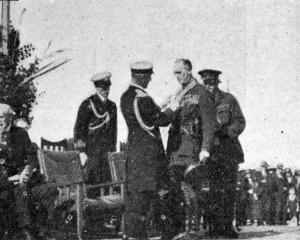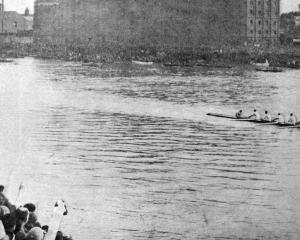When the Maori Contingent was organised, however, it had no badge and no motto, for the simple reason that it had no parent unit in the National Force.
This difficulty was happily overcome by Dr Pomare, the Native Minister, who designed a special badge for the occasion, which has been cast in bronze, and is now being worn by members of the Maori Contingent on the front of their helmets.
The badge is of neat design, comprising a crown with a Maori battleaxe and spear running through it and an encircling border bearing the following inscription: - ''Te Hoko-Whitu A Tu''.
The inscription is a purely legendary one, going back into the twilight of the fable.
The literal translation is ''Seventy of the God of War'', while the ordinary meaning is ''Very Desperate Unto Death''.
In bygone ages 70 specially-fitted warriors were invariably chosen as the fighting squad of the Natives for any desperate enterprise, and the custom was handed down until quite modern times.
The members of the Maori Contingent, although they number more than the legendary 70, are nevertheless the chosen of the Maori race, and may be relied upon to give a good account of themselves.
The side badges of red and black cloth worn by the Maori soldiers on their helmets are the Maori colours.
• As a consequence, no doubt, of the strong westerly winds prevailing during the last few days, the erosion of the sea beach at St. Clair is more conspicuous than ever.
A noticeable result of the sluicing process that has lowered the level of the beach by many feet is the manner in which the surf, when the sea is at all heavy, runs, at from half to full tide, right in till it meets the resistance of the artificial barriers created.
The concrete steps leading from the main esplanade to the beach below would be suspended, like Mahomet's coffin, in mid-air, but for the masses of stone piled recently beneath to support them.
The attack of the sea is particularly heavy at present on the northern end of the new sea wall that is in process of construction with a view to the formation of a marine parade, though the whole length of the wall is awash for hours at each tide.
As a consequence, the base of the wall, which is of loose rock, is showing a marked disposition spread itself seaward.
The surf has carried many rocks, large and small, bodily out to sea, and as the tide recedes there can be seen strewn over what, within the memory of the oldest inhabitant, has never been anything but a strip of virgin sand.
Yesterday at low water men were to be seen engaged in the somewhat pathetic task of gathering up these errant pieces of the wall and replacing them in the position from which they had strayed.
Their labour was somehow reminiscent of the energy of the celebrated Mrs Partington in her attack on the Atlantic Ocean, for, later, when the tide had risen, stones could again be seen merrily careering seaward in the backwash.
If this sort of thing goes on those in charge of this interesting work at St. Clair will at least be able to claim, perhaps, that they have discovered a permanent avenue of employment for the unemployed.
• A plague of hedgehogs is evidently as bad for the poultrykeeper as an incursion of weasels.
Most farmers know the hedgehogs have a pronounced partiality for eggs, but until recently they considered that their well-grown chickens were safe.
But Leeston is just at present suffering from an unusual horde of hedgehogs, and the lives of the domestic fowls are precarious (says the Christchurch Sun).
Several farmers have had their flocks of egg-producers seriously depleted, and one lost 10 young turkeys in a single night.
There is no doubt that hedgehogs are the marauders, for several which have been killed have had traces of feathers round their mouths. - ODT, 20.2.1915.
• COPIES OF PICTURE AVAILABLE FROM ODT FRONT OFFICE OR WWW.OTAGOIMAGES.CO.NZ












